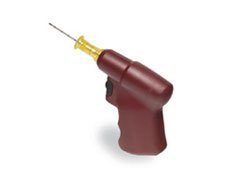
Categorised under:
Anaesthesia
>
Vascular access
>
Intraosseous devices
Orthopaedics
>
Trauma
>
Vascular access and control
This is another device which has rapidly travelled from the battlefield to civilian practice. Intravenous access is difficult in many pre-hospital and resuscitation situations. Traditionally, central access or cut downs have been advocated, neither of which are ideal (either due to equipment and time constraints, or the technical demands of the task). Hand held intraosseous devices have been available for many years, but are not particularly satisfactory (either because they are difficult to insert in adult bones, or because they cause oval insertion holes when screwed in by hand, thus facilitating extravasation of any infused fluid). The EZ-IO (and to a much lesser degree, the sternal I-O)solve this problem.
This is another device which has rapidly travelled from the battlefield to civilian practice.
Intravenous access is difficult in many pre-hospital and resuscitation situations. Traditionally, central access or cut downs have been advocated, neither of which are ideal (either due to equipment and time constraints, or the technical demands of the task).
Hand held intraosseous devices have been available for many years, but are not particularly satisfactory (either because they are difficult to insert in adult bones, or because they cause oval insertion holes when screwed in by hand, thus facilitating extravasation of any infused fluid). The EZ-IO (and to a much lesser degree, the sternal I-O) solve this problem.
EZ-IO is basically an electric hand drill with a choice of needle attachments- pink, yellow and red. Training (even unskilled, non medical staff) takes less than five minutes.
Insertion is easy, although care should be taken not to drill until the flange hits (and potentially damages) skin overlying the insertion site. Checking the needle is correctly sited in bone is simple- gently confirm that the needle is not mobile (for example, it is easy to miss the humeral head in patients with well developed deltoid muscles). Aspiration of marrow is another confirmatory sign.
The IV connector should be attached and the line flushed. The initial injection of fluid is frequently uncomfortable, but this is transient, and of less relevance for unconscious or critically ill patients.
Disadvantages of the EZ-IO are the sealed unit design, which means that the battery cannot be replaced. Also, the initial cost is significant, and it is sufficiently portable that sticky fingered staff may be attracted to it.
Dr Ian Nesbitt, Anaesthesia & Critical Care Consultant, Newcastle upon Tyne, UK - No Conflict Declared
Ian Nesbitt qualified from Newcastle upon Tyne Medical School, trained in the UK, Australia and New Zealand. He works as a consultant in the NHS in Anaesthesia & Critical Care.

Did you know you can Register for FREE with this website?
Registration gives you full access to all of the features of WhichMedicalDevice. Find out more ...
WhichMedicalDevice is a FREE resource created by clinicians for clinicians.
Registration is free and gives you unlimited access to all of the content and features of this website.
Find out more...Registration is free and gives you unlimited access to all of the content and features of Which Medical Device. Find out more...
Which Medical Device is a community of clinicians sharing knowledge and experience of the devices and procedures we use on a daily basis. We ask that our members register with us so that we can maintain the unbiased and independent nature of our content. Registration is quick and free.
We do not make your details available to any third parties nor do we send unsolicited emails to our members. You can read our Privacy Policy here.